
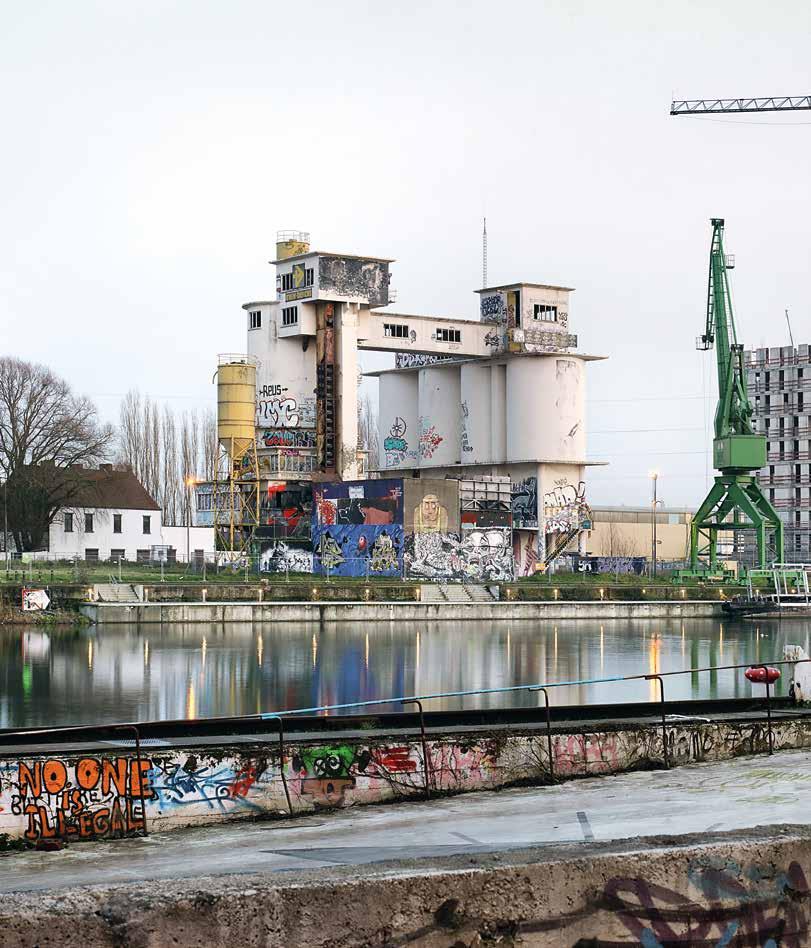

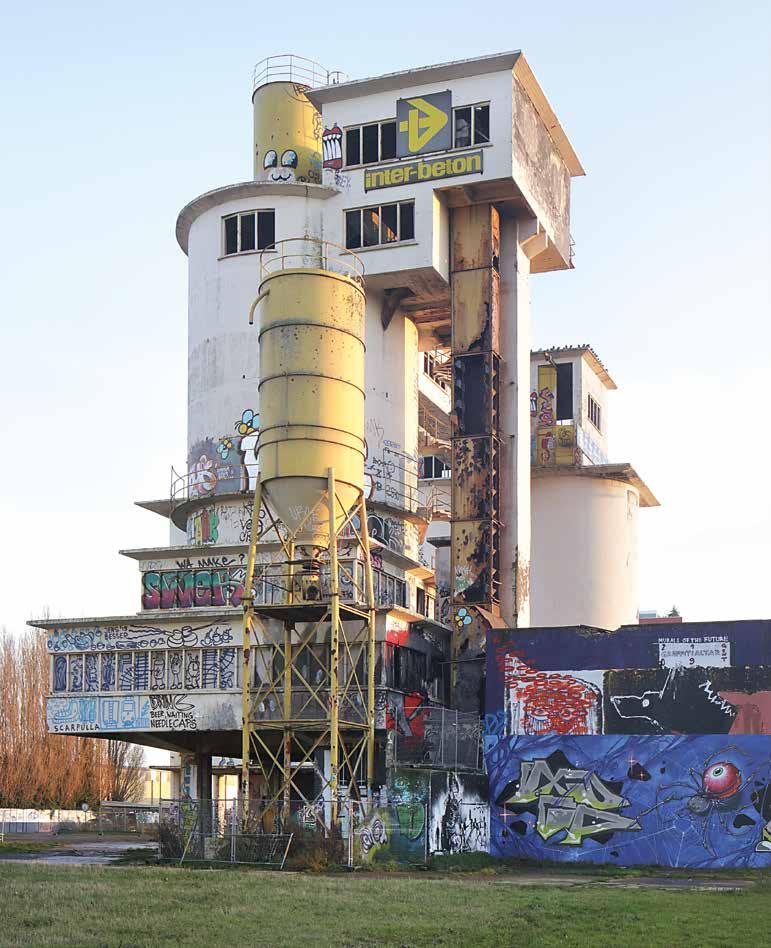
In 2009, the Inter-Beton cement and concrete factory ceased operations, as part of a restructuring program symptomatic of Europe’s declining industry in recent decades. Entering a prolonged state of limbo, it began to transition into an interesting liminal space – a no-man’s-land of possibility. There is a nostalgic attraction to be found in such inbetween places that are suspended in time. As this book celebrates, in the years following its closure, the concrete factory has had an inspiring and unexpected swansong as a creative concrete playground for artists both local and international. It has become a special landmark for public art that has helped ‘cement’ (excuse the pun) Ghent’s place on the global urban art stage. Graffiti and street art in abandoned places do not always get the same attention as murals in city centre locations or feature as widely in books; nevertheless, this is where some of the most experimental and free art can be found. The wild and eclectic art that has been able to roam free here is our principal subject, but the twisted steel, rusting silos and crumbling stairwells are an integral part of the atmosphere and the artworks themselves.
Abandoned buildings and neglected areas are of course essential environments for self-authorised art, spaces that are not too precious or policed that can be transformed into an artistic environment. Belgium in particular plays host to numerous abandoned industrial sites which include mines, factories and workshops, as well as other decaying structures such as old barracks, villas, castles and even deserted villages such as Doel (another extraordinary graffiti hotspot). These relics of the past are a reminder that nothing lasts forever. Derelict spots can be hugely fascinating, which has led to a growing urban exploration scene worldwide. Urban explorers seek out these sometimes hard-to-find and often off-limit locations, usually to photograph and document them before they are destroyed or reclaimed by nature. They are drawn to the faded grandeur of the crumbling architecture, its history and the beauty of the urban decay. These aesthetic qualities hold a similar attraction for street artists, who are often some of the first urban explorers to discover deserted places.

In 2009 staakte de cement- en betonfabriek van InterBeton haar activiteiten, deels door een herstructureringsprogramma dat symptomatisch was voor de neergang van de Europese industrie in de laatste decennia. Het werd het begin van een lange leegstand en een interessante overgangstoestand – een no man’s land van mogelijkheden. Dergelijke in de tijd opgeschorte, provisorische plekken bezitten een nostalgische aantrekkingskracht. Zoals uit dit boek blijkt, reïncarneerde de Betoncentrale de jaren na haar sluiting een laatste keer als betonnen speelterrein voor zowel lokale als internationale kunstenaars. Het werd een uniek baken van streetart, dat Gent een eigen plaats gaf op de wereldkaart van de stadskunst. Graffiti en streetart in leegstaande gebouwen krijgen niet altijd dezelfde aandacht als muurschilderingen in stadscentra en worden minder gereproduceerd in boeken. Niettemin zijn het de plaatsen waar vaak de meest experimentele vrije kunst kan worden gevonden. De onstuimige en eclectische kunst die in de Betoncentrale woekerde tussen verwrongen staal, roestende silo’s en afbrokkelende trappenhuizen vormt het belangrijkste onderwerp van dit boek.
Leegstaande gebouwen en braakliggende terreinen zijn natuurlijk de plek bij uitstek voor ongebonden kunst. Het zijn ruimten die niet al te geraffineerd en gecontroleerd zijn en makkelijk getransformeerd kunnen worden tot een artistieke omgeving. België bezit tal van dergelijke verlaten industriële sites – voormalige mijnen, fabrieken, ateliers – en ook andere structuren in verval, zoals barakken, villa’s, kastelen en zelfs verlaten dorpen, zoals Doel (nog een bijzondere hotspot voor graffiti en streetart). Deze relieken uit het verleden herinneren eraan dat niets eeuwig blijft. Vervallen plekken kunnen bijzonder fascinerend zijn, wat heeft geleid tot een wereldwijd groeiende scene van mensen die ze gaan exploreren. Urban explorers (letterlijk: stadsverkenners) gaan op zoek naar soms moeilijk te vinden en vaak verboden locaties, meestal om ze te fotograferen en te documenteren vooraleer ze worden gesloopt of door de natuur overwoekerd. Ze worden aangetrokken door de vergane glorie van de verbrokkelende architectuur, haar geschiedenis en de schoonheid van stedelijk verval. Deze esthetische kwaliteiten hebben dezelfde aantrekkingskracht voor streetartkunstenaars, die vaak de eerste urban explorers zijn om deze verlaten plekken te ontdekken.
Bué the Warrior, ROA, Resto en Sam Scarpulla waren zowat de eerste lokale kunstenaars die hun stempel zetten op de Betoncentrale. Ze worden allemaal beschouwd als voortrekkers, medewerkers en vernieuwers van de lokale artistieke scene. Gedurende een paar decennia bleven deze kunstenaars terugkeren naar de fabriek en bepaalden ze mee het visuele karakter van de hier gecreëerde kunst en de open, toegankelijke sfeer van de plek. Er waren geen stilistische regels over wat hier werd geschilderd – klassieke graffitiletters staan broederlijk naast muurschilderingen, verfijnde kunst wordt vermengd met stripfiguren en abstractie gaat samen met figuratie. De code voor een feestje van de streetart is: kom zoals je bent en breng je eigen verf mee.
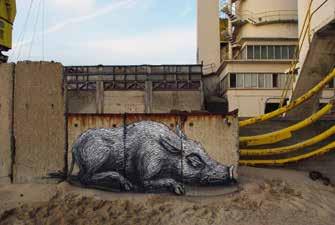
Among the first local artists to start making their mark at the concrete factory were Bué The Warrior, ROA, Resto and Sam Scarpulla, all of whom are highly regarded as instigators, collaborators and innovators in the local art scene. These artists continued to return to the space in the following decades, helping to shape the visual character of the art created here and the freefor-all vibe of the place. There are no stylistic rules as to what gets painted here – classic graffiti letters sit alongside murals, fine art mixes with comic art and abstraction meets figuration. The street art party invite code says: come as you are and bring your own paint.
In zekere zin dicteert het beschikbare oppervlak hoe het werk ontstaat – bijvoorbeeld met een spuitbus of met een verfborstel. Kunstenaars moeten de confrontatie aangaan met weerbarstige muren, gebarsten beton en roestig metaal. Sommigen spelen echter graag in op die texturen. Zo laat ROA voor zijn geliefde dierenbeelden bewust de ondergrond waarop hij schildert onbewerkt. Zonder een geschilderde achtergrond zijn de gedetailleerde werken gevoelige studies van licht en schaduw, wat de indruk wekt dat het dier in een ruimte woont. Deze ‘geenachtergrondtechniek’ is ook een geliefkoosde tactiek van lokale legendes Bué en Resto, van wie het werk meer stripachtig is. Beide kunstenaars werken vooral met figuren. Bué’s kleurrijke creaturen hebben nadrukkelijke, afgelijnde contouren, terwijl Resto’s satirische tekeningen eerder werken met nuances en dunnere contouren. Hun stijl met krachtige kleuren komt goed tot zijn recht in contrast met de verweerde kleuren van de stedelijke texturen.
To some extent the surfaces available dictate how the work is created – for instance, whether to use a spray can or a paintbrush. Artists must contend with unforgiving exteriors, cracked concrete and rusty metal; however, some choose to make a feature of these textural supports. For instance, ROA’s much-loved animal images are recognised for their distinct lack of painted backgrounds. Without a background, his detailed paintings are sensitive studies of light and shade which give the impression of the animal inhabiting a space. This ‘no background’ technique is a popular tactic with local art legends Bué and Resto, whose work is more comicbased. Both artists work primarily with characters. Bué’s colourful creatures and figures have distinctively smooth outlines, while Resto’s satirical drawings have a touch of shading and thinner outlines. Their visual style works to great effect in contrast with the urban textures as their punchy colours pop out against the gritty, weather-worn hues.


Bué’s and Resto’s art catches the eye, as does that of many of their contemporaries, regardless of being created on the street. Nevertheless, painting the work in the environment creates another dimension and level of meaning. In the case of Bué, Resto, Topo and others, their character designs are brought to life outdoors as if they were players on a giant street-wide stage, incorporating real-life features as additional props to the work, for a surreal and at times absurd effect.
Central to any consideration of urban art is unquestionably this aspect of positioning and composition. While many artforms take space and location into consideration, particularly public art forms such as sculpture and installations, self-authorised art pushes the limits of what can be created within the whole environment. A wall or a building is part of a continuous landscape; unlike a framed artwork in a gallery, it is experienced without the constraints of fixed framing. The work is encountered in everyday life or viewed from unexpected angles. One artist already mentioned who has turned the choice of location into an art form is ROA, as we see in several of his works across the site such as the iconic image of a dead stork wrapped around a tower, appearing to be suspended from an outside spiral staircase. ROA’s work often features deceased animals, and the narrative conveyed in this and other pieces is that the human environment
comes at a price to our fellow sentient beings, with the loss of habitat and pollution that the modern world has caused. The backdrop of the urban wasteland serves as a metaphor for the Anthropocene epoch.
Urban art by its very nature celebrates the ephemeral. The once functional buildings and walls found at the concrete factory are now temporal as the elements slowly take their toll on their structures. Within this process, there are ideas to be explored and images that can be conjured up from decay, as we see in some of the pieces by Bisser, an artist from Leuven who has spent some years in Ghent. Bisser’s art is figurative and tends to be quite ethereal, at times translucent. Using subtle layering of paint, Bisser has adorned many walls here with this arresting technique, such as one broken wall with exposed steel innards whose crumbling outline has been transformed into an isolated head that appears to be mournfully crying out to the sky. In the public space, naturally artists add their work to the surfaces they find. These façades will have existing textures and perhaps existing artworks, with newly painted graffiti adding another layer to what was there before. This layering process inherent to graffiti can be seen as a city-wide palimpsest. Palimpsest is a historical term referring to a manuscript whose text has been scraped or washed off for reuse so that layers of text are discernable. In colloquial terms, the word eloquently describes the superimposed nature of urban art.
De op straat tot stand gekomen kunstwerken van Bué, Resto en vele van hun tijdgenoten zijn echte blikvangers. Het schilderen in deze omgeving geeft de werken een andere dimensie en een ander betekenisniveau. In het geval van Bué, Resto, Topo en anderen komen de figuren buiten tot leven, alsof het spelers zijn op een reusachtig podium, waarbij ze reëel bestaande elementen als rekwisieten inlijven, wat tot surreële en soms absurde effecten leidt. Dat aspect van positioneren en compositie is ongetwijfeld een centraal element van streetart. Terwijl veel kunstvormen – vooral sculpturen en installaties voor de openbare ruimte – rekening houden met ruimte en locatie, tast eigenmachtige kunst de grenzen af van wat binnen het totaalbeeld kan worden gecreëerd. Een muur of een gebouw is onderdeel van een doorlopend landschap. Anders dan een ingelijst kunstwerk in een museum wordt het ervaren zonder de beperkingen van een vaste lijst. Het werk bevindt zich in de alledaagse omgeving of wordt vanuit onverwachte hoeken zichtbaar. ROA, die we al eerder hebben vermeld, heeft een bijzonder talent voor de keuze van locaties. Dat blijkt uit verschillende van zijn werken op de site, zoals het iconische beeld van een rond een toren gewikkelde, dode ooievaar, die lijkt te worden opgetild door een buitenwenteltrap. ROA schildert vaak overleden dieren, waarmee hij wil wijzen op de nefaste invloed van de mens op andere levende wezens, die uit hun natuurlijke habitat worden verdreven, en op de pollutie die de moderne wereld heeft veroorzaakt. De achtergrond van het stedelijke braakland fungeert als metafoor voor het antropoceen.
Een essentieel element van streetart is zijn vergankelijkheid. De ooit functionele gebouwen en muren van de Betoncentrale werden tijdelijk naarmate de elementen hun structuur langzaam begonnen aan te vreten. Dat proces van verval inspireert tot nieuwe ideeën en beelden, zoals blijkt uit een aantal pieces van Bisser, een kunstenaar uit Leuven die enkele jaren in Gent woonde. De kunst van Bisser is figuratief, neigt naar het etherische en is soms zelfs doorschijnend. Bisser brengt subtiel verschillende lagen verf aan en beschilderde hier menige muur met deze fascinerende techniek. Een perfect voorbeeld is de monolithische figuur op een muur met zichtbaar geworden ingewanden van stalen buizen, die een droeve kreet naar de hemel lijkt te richten. In de openbare ruimte voegen kunstenaars als vanzelfsprekend hun werk toe aan de oppervlakken die ze vinden. Deze muren hebben bestaande texturen en misschien ook al muurschilderingen, waarop nieuwe graffiti een extra laag toevoegen aan wat er al was. Die opeenstapeling van lagen is inherent aan graffiti en kan worden gezien als een over de hele stad verspreide palimpsest. Dat is een historische term voor een manuscript waarvan de tekst voor hergebruik werd weggeschraapt of afgewassen, maar waarbij de verschillende lagen tekst nog zichtbaar blijven. In een niet-wetenschappelijke context is de term perfect toepasselijk op de gelaagde aard van streetart.
Graffiti en streetart creëren een collageachtig patchwork van alternatieve tekens in een stedelijk landschap dat zelf een gelaagd en complex samenstel is van verschillende structuren, kleuren en visuele elementen zoals signalisatie en reclameborden. Ze voeren een strijd om aandacht en voegen constant nieuwe lagen toe. Er kan samenwerking tussen kunstenaars ontstaan, zelfs zonder dat ze elkaar ontmoeten – verschillende kunstenaars voegen nieuw werk toe aan muren, soms het werk van anderen overlappend zoals bij een palimpsest, of ze zetten het zij aan zij om een groeiende ‘tijdscollage’ te creëren. In de Betoncentrale zijn mooie voorbeelden te vinden van beide types – de collage en de palimpsest – zoals de grootschalige ‘Keep It Sport’-figuur geschilderd door Resto, die later is opgenomen in een muurschildering van monsterlijke creaturen van de lokale schilder en tatoeëerder Samor. Voor regelmatige bezoekers aan de site resulteerde dit surrealistische ‘cadavre-exquisspel’ in een soort magie die ontstaat als kunstenaars een ruimte delen, maar die zelden optreedt bij atelierkunst.

Voor veel kunstenaars is dit samenkomen en -werken met vrienden een deel van het plezier van het schilderen in de openbare ruimte. Inspiratie kan ook van de ene kunstenaar op de andere overgaan, als onderdeel van het spontane proces. Terwijl sommige kunstenaars het verkiezen solo te gaan en in hun eigen creatieve zone te blijven, is er ook een grote camaraderie onder de lokale kunstenaars en een enthousiasme om samen te werken. Die open mentaliteit is een van de redenen waarom Gent zo bekend is geworden in de wereld van de streetart. Lokale kunstenaars inviteerden in de loop der jaren immers kunstenaars uit de hele wereld om in de stad te komen schilderen. Rond het stadscentrum zijn er tal van legale en illegale muren die formeel of informeel werden beschilderd tijdens streetartfestivals en artistieke projecten. Dat internationale netwerk werkt in beide richtingen. Belgische kunstenaars werden uitgenodigd om te gaan schilderen in de hele wereld, wat ertoe heeft geleid dat sommigen zich elders vestigden. Zo woont Bué tegenwoordig in Mexico, waar hij actief is in de bruisende Mexicaanse wereld van de streetart.
Essentially, graffiti and street art create a collage-like patchwork of alternative signs against an urban landscape that is itself a complex layering of different structures, colours and visual features such as signage and billboards. There is a fight for attention and a constant overlaying process in effect. Collaborations between artists can occur even without meeting – different artists add new work to walls, sometimes going over each other’s work in palimpsest or with work placed side by side to create a growing ‘time collage’. At the concrete factory there are some great examples to be found of both the collaging and palimpsesting processes, such as the large-scale ‘Keep It Sport’ character painted by Resto has been subsumed by a mural featuring monstrous creatures by local painter and tattoo artist Samor, not only once but in two iterations. For regular visitors to the site, this Surrealist game of ‘exquisite corpse’ is the kind of magic that can happen when artists share a space, something that rarely happens in studio-based art.
For many artists, meeting up with friends and working together is part of the joy of painting in a public space. Inspiration can also flow from one artist to the next as part of the spontaneous process. While some artists prefer to go solo to get into their own creative zone, there is a great camaraderie between local artists and an eagerness to work with others. Famously, this companionship is one of the reasons that Ghent has become so well known in the street art world, as local artists have over the years been very hospitable in inviting artists from all over the globe to stay and paint in the city. Around the city centre there are a multitude of legal and illegal walls that have been painted formally or informally through street art festivals and art projects. This global network works both ways, as Belgian artists have been invited to paint around the world, which has even led to artists settling elsewhere. Today, for instance, Bué is based in Mexico City, now a prolific player on the vibrant Mexican street art scene.

Gent staat bijzonder positief tegenover de voordelen van publieke kunst en de Betoncentrale heeft een belangrijke rol gespeeld als experimenteerruimte, zonder de beperkingen van permanente muurschilderingen of formele tentoonstellingen. Het was een plek waar kunstenaars nieuwe dingen konden uitproberen, op grotere schaal werken en onconventionele visuele ideeën konden uitwerken. De kunst die hier werd gecreëerd, ademt de onafhankelijke geest van kunstenaars die hun eigen creatieve pad volgen, zoals in het werk van Cee Pil, die van Oostende afkomstig is, maar nu in Gent woont. In zijn kunst versmelt Cee Pil fotorealistische beelden van dieren op ongebruikelijke en originele manieren, alsof hij ze pelt en aan elkaar rijgt. Kunstenaar Sam Scarpulla maakt dan weer gebruik van geometrische symbolen en narratieve beelden in muurschilderingen die stilistisch verwant zijn aan zijn linosneden. Ook Klaas Van der Linden werkt in verschillende stijlen. Hij creëert verbazende landschappen en sociale portretten, maar is wellicht het meest bekend voor zijn altijd evoluerende reeks zwart-witsilhouetten en skeletten die nadenken over de zin van het leven, de maatschappij en de dood. Deze drie kunstenaars illustreren verschillende artistieke benaderingen en hebben elk een eigen manier gevonden om de openbare ruimte – die ook hun atelierwerk beïnvloedt – naar hun hand te zetten. Zowel onder invloed van het karakter van de kunstenaars als van de site-specifieke en wilde aard van eigenmachtige kunst, leidt het vrijelijk in de stedelijke ruimte werken tot een bijzonder creatieve artistieke productie die zinvol, innemend en uiterst levendig is. De beelden van dit betonnen speelterrein waren daar een sprekend voorbeeld van.

While Ghent is remarkably receptive to the creative benefits of public art, the Betoncentrale has played an important role as a space to experiment, free from the constraints of a permanent mural or formal exhibition. It’s a place for artists to try something in a new way, perhaps working at a larger scale or trying some unconventional visual ideas. The art that has been created here has an independent spirit as artists explore their own creative path, as we see for instance in the work of Cee Pil, originally from Ostend but now based in Ghent. Cee’s art blends photorealistic images of animals in unusual and original ways as though peeling and threading them together. Belgian-American artist Sam Scarpulla creates art using geometric symbols and narrative images, while his murals are stylistically related to his linocut printing. Also working in several styles is local artist Klaas Van der Linden, who creates stunning landscapes and social portraits, while probably most recognised for his ongoing black-and-white silhouette series featuring skeletons which contemplate the nature of life, society and death. These three artists illustrate remarkably different artistic approaches that have all found an engaging way to use public space, which also informs their studio-based work. Whether it’s in the nature of the artists or the site-specific and wild nature of self-authorised art, working freely in the urban environment as we saw in this concrete playground always seems truly creative work that is meaningful, engaging and full of life.

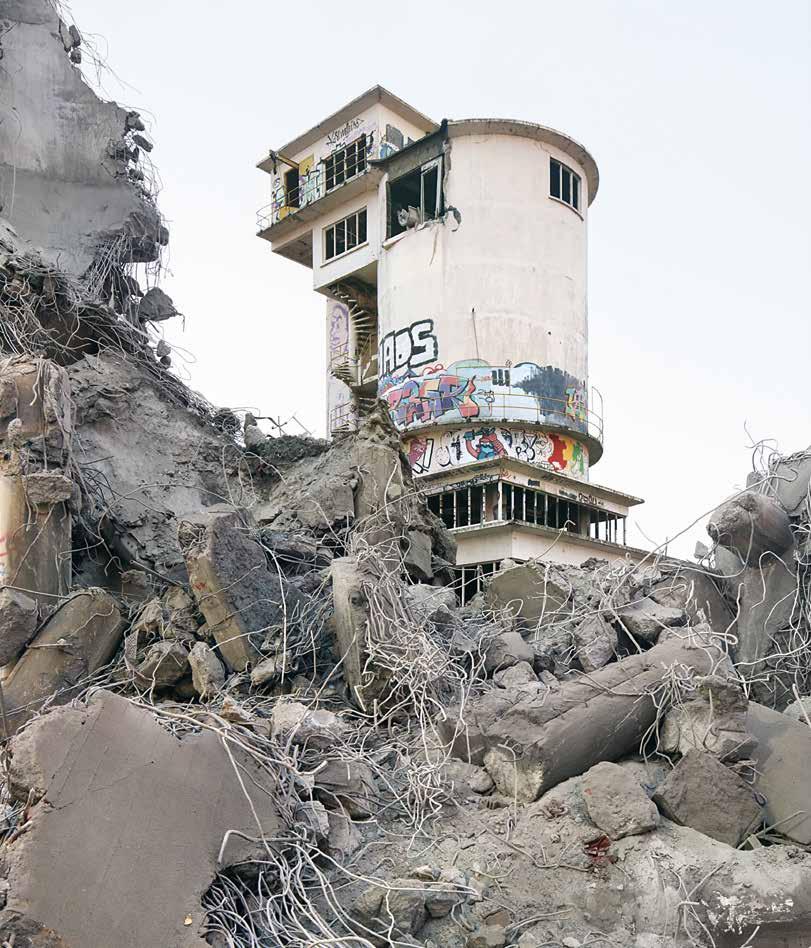
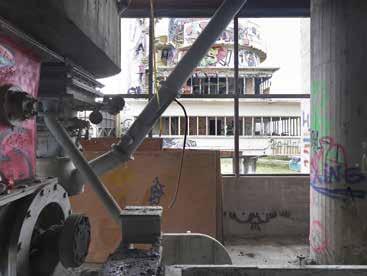

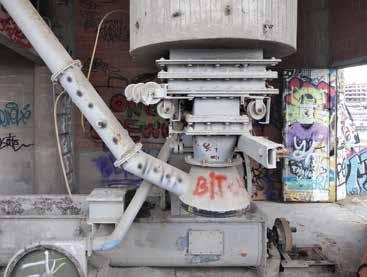
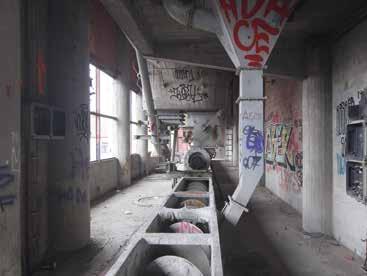
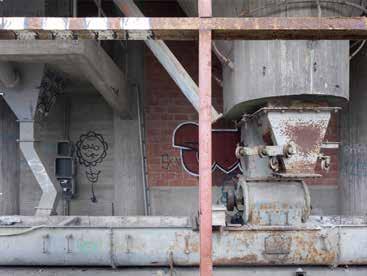

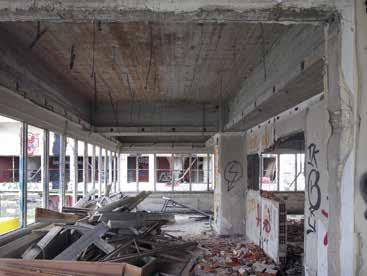

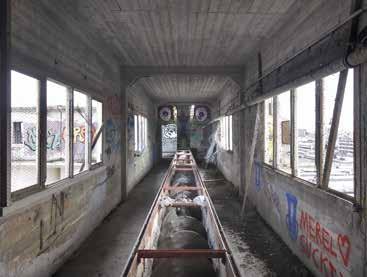
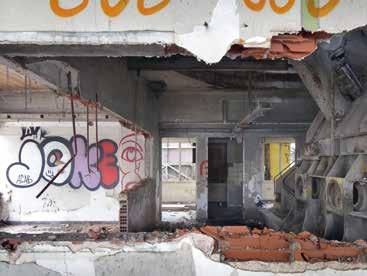
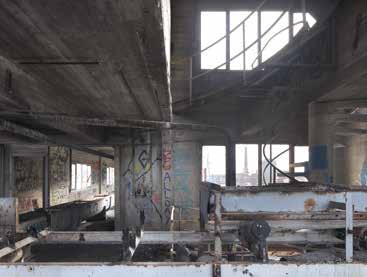
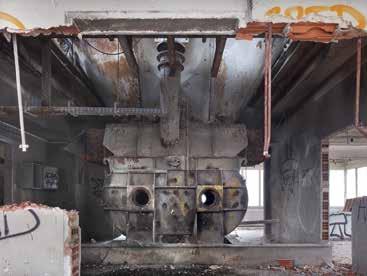



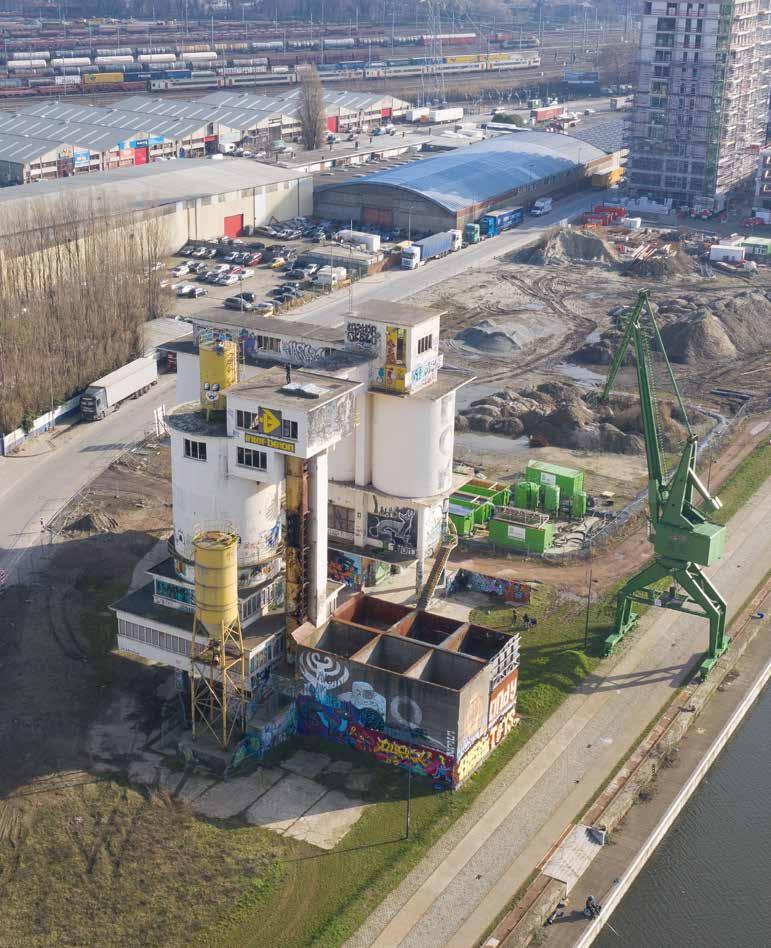
As a building material, concrete was an integral part of twentieth-century Belgian architecture. It consists of cement supplemented by one or more other materials, such as sand, gravel or rubble. Concrete is cheap, simple and stable. Centuries ago, the Egyptians, Babylonians, Greeks and Romans were already using plain concrete. The technique subsequently fell into disuse and it was not until the eighteenth century that concrete was picked up again. The invention in 1824 of Portland cement as a binding agent improved concrete construction. The first experiments with reinforced concrete followed around 1845. This combination of concrete and steel rods (rebar) provided greater stability.
Initially, there was a great deal of resistance to the new building material, but in the second half of the nineteenth century, cement and concrete took off. Although the focus of the cement industry was in the Walloon industrial basin, Ghent also had a number of companies that produced large quantities of cement and cement tiles. The companies Picha and Fièvé built up a solid reputation. Especially after the First World War, the Belgian cement and concrete industry expanded enormously. From 1959 onwards, concrete batching plants were created, industrial complexes whose function was to process raw materials into ready-mixed concrete. Concrete mixers drove back and forth to supply construction sites with readymixed concrete. In the 1960s, the companies Gent-Beton and Ciments d’Obourg each filed for planning permission for a concrete plant with a concrete mixing tower, laboratory, silos, offices and garages between Koopvaardijstraat and Handelsdok in Ghent. Construction proceeded in different phases. The two plants were merged in 1967 and run by Inter-Beton. The company’s yellow trucks are still etched into the collective memory today.

HILDE LANGERAERT
Beton valt als bouwmateriaal niet weg te denken uit de Belgische architectuur van de 20e eeuw. Het bestaat uit cement, aangevuld met een of meerdere andere materialen, zoals zand, grind of steenslag. Beton is goedkoop, eenvoudig en stabiel. Eeuwen terug gebruiken de Egyptenaren, Babyloniërs, Grieken en Romeinen al ongewapend beton. Daarna raakt de techniek in onbruik en pas vanaf de 18e eeuw wordt beton terug opgepikt. De uitvinding van portlandcement in 1824 als bindmiddel verbetert de betonconstructie. Rond 1845 volgen de eerste experimenten met gewapend beton. Die combinatie van beton en stalen staven – betonijzer – zorgt voor meer stabiliteit.
Aanvankelijk heerst er veel weerstand tegen het nieuwe bouwmateriaal, maar in de tweede helft van de 19e eeuw kennen cement en beton een opmars. Hoewel het zwaartepunt van de cementindustrie in het Waalse industriële bekken ligt, kent ook Gent enkele bedrijven die grote hoeveelheden cement en cementtegels produceren. Zo bouwen de firma’s Picha en Fièvé een stevige reputatie uit. Zeker na de Eerste Wereldoorlog neemt de Belgische cement- en betonindustrie een hoge vlucht. Vanaf 1959 zien ook betoncentrales het licht, industriële complexen met als functie de overslag van grondstoffen en de verwerking ervan tot stortklaar beton. De zogenaamde truckmixers of betonmixers rijden af en aan om bouwwerven van kant-en-klaar beton te voorzien. De firma’s Gent-Beton en Ciments d’Obourg dienen in 1960 elk een bouwaanvraag in voor een betoncentrale met betonmengtoren, een laboratorium, silo’s, kantoren en garages tussen de Gentse Koopvaardijstraat en het Handelsdok. De bouw verloopt in verschillende fases. Vanaf 1967 worden beide centrales samengevoegd en gerund door Inter-Beton. De gele vrachtwagens van het bedrijf staan tot op vandaag in het collectieve geheugen gegrift.
